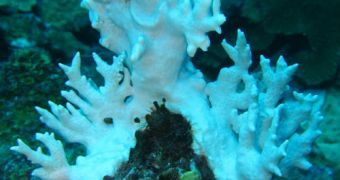Experts at the US National Oceanic and Atmospheric Administration (NOAA) announce that, in all likelihood, coral reefs in the Caribbean Sea will exhibit the phenomenon known as bleaching in 2010.
This will affect the southern and southeastern Caribbean most of all, but other areas will be at risk as well. Bleaching is caused by a large increase in ambient water temperatures around the reefs.
According to the research team, it could be that this year's bleaching will be as large as 2005's, which had devastating effects on corals living in this region of the Atlantic Ocean.
The phenomenon will reach its peak in October, and could affect as many as 80 percent of all the corals in the sea. About 40 percent of the entire coral population might die off, similarly to how things happened 5 years ago.
The new estimates were derived from the analysis of data collected under the NOAA Coral Reef Watch (CRW) monitoring system, which monitors coral bleaching using satellite-based surveillance.
Throughout the Caribbean Sea, data from the eye-in-the-sky shows elevated, higher-than-normal temperatures, which remain at high values for longer periods of time than normal.
“The early warning predictions of [the] NOAA CRW program are vital to assist coral reef managers in making early preparations for coral bleaching events,” explains scientist Billy Causey.
“While managers can’t do anything immediately to prevent coral bleaching, these early warnings give them time to monitor and track the stressful event, thus learning more about both direct and secondary impacts of bleaching on coral reefs around the world,” he adds.
Causey is the southeast regional director for the NOAA Office of National Marine Sanctuaries. He adds that elevated temperatures were also recorded in western Gulf of Mexico and the southern portion of the Bahamas.
Coral bleaching is extremely dangerous for marine ecosystems. The reefs are home to countless fish and invertebrate species, which could all lose their spawning grounds if the corals die.
This may happen when prolonged bleaching occurs. This is why conservation programs and mitigation measures must always remain one step ahead.
“High temperatures cause corals to force out the symbiotic algae that provide them with food,” says CRW coordinator, Mark Eakin, PhD.
“This makes the corals appear white or 'bleached' and can increase outbreaks of infectious disease. Temperatures are high in the Caribbean, and we expect this to continue,” he adds.
“This season has the potential to be one of the worst bleaching seasons for some reefs,” Eakin concludes.

 14 DAY TRIAL //
14 DAY TRIAL //